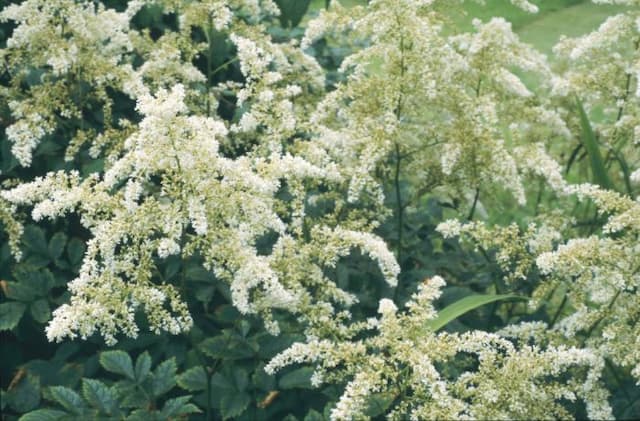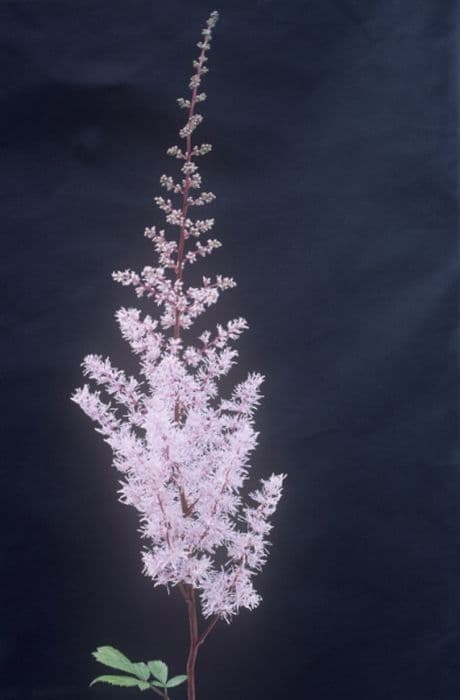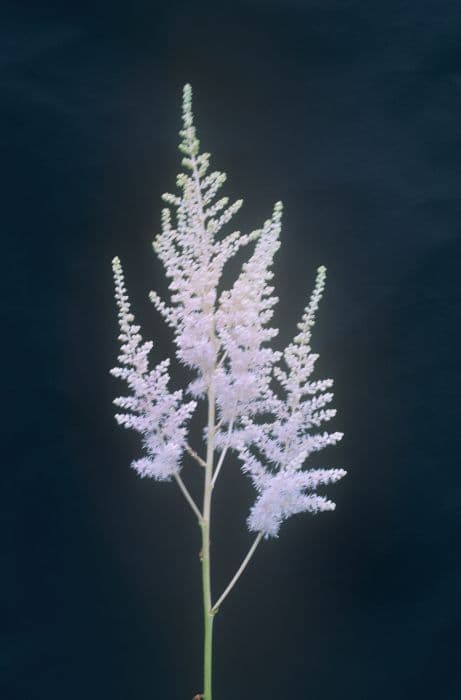Coral Bells Heuchera 'Ginger Peach' (PBR)

ABOUT
Heuchera 'Ginger Peach' is a striking perennial known for its unique and attractive foliage. The leaves of this plant exhibit a dynamic color palette that changes with the seasons. During spring, the foliage emerges with a peachy-orange hue, casting a warm glow in the garden. As the plant matures into summer, the leaves transition into a blend of amber and ginger tones, reminiscent of the spices after which it's named. In the autumn, the foliage deepens further into a rich, burnished red, providing spectacular late-season interest. The leaves are rounded, with a lobed edge that gives them a ruffled appearance. Veins may be slightly more pronounced, offering a subtle textural contrast. In addition to its colorful foliage, 'Ginger Peach' sends up delicate stems above the foliage where clusters of small, bell-shaped flowers bloom. These blossoms are typically cream or light pink in color, adding a contrasting softness to the bold leaves below. The flowers attract pollinators such as hummingbirds and butterflies, making the plant not only visually appealing but also beneficial for the local ecosystem. 'Ginger Peach' forms a mounding clump that serves as an excellent ground cover or edge plant in a border. It is often used in landscaping for its multi-seasonal interest and low maintenance requirements. This cultivated variety thrives in a range of garden settings, from partially shaded woodland areas to sunnier spots with adequate moisture. Its vibrant foliage color and textured appearance make it a standout addition to any ornamental garden space.
About this plant
 Names
NamesFamily
Saxifragaceae
Synonyms
Coral Bells, Alumroot
Common names
Heuchera 'Ginger Peach' (PBR)
 Toxicity
ToxicityTo humans
Coral Bells, which includes the Heuchera 'Ginger Peach', is generally considered non-toxic to humans. Ingesting parts of the plant typically does not result in poisoning or adverse health effects. Therefore, no specific symptoms associated with poisoning are documented for this plant when it comes to human ingestion.
To pets
Coral Bells, like the Heuchera 'Ginger Peach', are generally known to be non-toxic to pets as well. It is unlikely for pets such as dogs and cats to experience poisoning or adverse effects from ingesting parts of this plant. As a result, there are no specific symptoms of poisoning associated with the Coral Bells in pets.
 Characteristics
CharacteristicsLife cycle
Perennials
Foliage type
Evergreen
Color of leaves
Mixed
Flower color
White
Height
1-2 feet (30-60 cm)
Spread
1-2 feet (30-60 cm)
Plant type
Herb
Hardiness zones
4
Native area
North America
Benefits
 General Benefits
General Benefits- Attractive Foliage: Heuchera 'Ginger Peach' features unique, peach to amber-hued leaves that provide ornamental value throughout the seasons.
- Easy Care: This plant is known for being low maintenance, requiring minimal care once established, making it suitable for gardeners of all skill levels.
- Drought Tolerant: Once established, Heuchera 'Ginger Peach' is resistant to drought, reducing the need for frequent watering.
- Shade Tolerant: It performs well in shaded areas where other plants might struggle, offering design flexibility for gardeners.
- Long-Lasting: Heuchera 'Ginger Peach' offers longevity as a perennial, coming back year after year.
- Seasonal Interest: This variety provides year-round interest with its evergreen foliage in mild climates and seasonal color changes.
- Attracts Pollinators: The flowers of Heuchera 'Ginger Peach' can attract butterflies and bees, contributing to the health of the local ecosystem.
- Non-Invasive: Heuchera 'Ginger Peach' remains compact and doesn’t spread aggressively, which helps maintain gardening boundaries.
- Versatile: This plant is suitable for a variety of garden uses including borders, ground cover, or container gardening.
- Frost Hardy: Heuchera 'Ginger Peach' can withstand cold temperatures, making it ideal for cooler climates where frost might be a concern.
 Medical Properties
Medical PropertiesThis plant is not used for medical purposes.
 Air-purifying Qualities
Air-purifying QualitiesThis plant is not specifically known for air purifying qualities.
 Other Uses
Other Uses- Photography Subject: The Heuchera 'Ginger Peach' with its stunning foliage can be used by photographers as a natural backdrop for macro photography or to add color depth to plant-based compositions.
- Culinary Garnish: Although not a common practice, the leaves of 'Ginger Peach' can be used as edible garnishes to add a splash of color to salads and desserts.
- Art Inspiration: Artists may draw inspiration from the unique coloration and patterns of the Heuchera 'Ginger Peach' when seeking new subjects or themes for their artwork.
- Temperature Indicator: Some gardeners observe the leaf color change in relation to temperature shifts, effectively using the plant as an informal gauge for temperature fluctuations in the garden.
- Fantasy Garden Element: Due to its otherworldly appearance, 'Ginger Peach' can be included in fantasy-themed gardens, which aim to create a whimsical or fairy-tale atmosphere.
- Erosion Control: When planted en masse, the root system of 'Ginger Peach' can help stabilize soil on slopes and prevent erosion.
- Livestock Forage: While not a common use, in the absence of preferred forage, some farm animals may graze on Heuchera if it's available in the pasture.
- Wedding Decor: Its vibrant peach foliage can be incorporated into wedding decor, offering a unique and natural aesthetic for table centerpieces or venue decorations.
- Bonsai Companion: Miniature gardening enthusiasts might use Heuchera 'Ginger Peach' as an accompanying plant to create a contrast or enhance the color palette around a bonsai tree.
- Seasonal Wreaths: The colorful leaves can be used to create or accentuate handcrafted wreaths, particularly for autumn when its colors match the season's palette.
Interesting Facts
 Feng Shui
Feng ShuiThe Coral Bells is not used in Feng Shui practice.
 Zodiac Sign Compitability
Zodiac Sign CompitabilityThe Coral Bells is not used in astrology practice.
 Plant Symbolism
Plant Symbolism- Adaptability: Heuchera, also known as Coral Bells, can thrive in various light conditions, symbolizing the ability to adapt to diverse environments and situations.
- Variety: The 'Ginger Peach' cultivar of Heuchera, with its unique colored foliage, represents the beauty of diversity and variety in life.
- Longevity: As a perennial plant, Coral Bells signify endurance and the passage of time, as they return year after year.
- Attraction: The bell-shaped flowers of Heuchera are known to attract hummingbirds and butterflies, symbolizing charm and the ability to draw others in.
 Water
WaterCoral Bells should be watered regularly, aiming for about 1 inch of water per week, which equates to approximately 0.623 gallons for each square foot of soil. It's best to check the top inch of soil for dryness and water if it's dry. To prevent leaf scorch and to encourage strong root development, it's recommended to water the plant at the base rather than overhead. During the hot summer months, you may need to water more frequently, while you should reduce watering in the cooler months. Always ensure good drainage to prevent root rot.
 Light
LightCoral Bells thrive in a location where they receive partial sunlight to light shade. They can tolerate morning sun but should be protected from the intense afternoon sun, which may cause the leaves to scorch. An ideal spot offers protection from harsh midday sun while still allowing for some dappled sunlight to enhance the vibrant leaf colors. It's a versatile plant that can grow under the cover of taller plants or in the natural light of a woodland setting.
 Temperature
TemperatureCoral Bells are hardy and can withstand a temperature range from about 0°F to 80°F. However, they thrive best in environments where temperatures stay between 50°F and 70°F. Extreme cold below 0°F may damage or kill the plant, so it's advisable to provide some winter protection in colder zones. Similarly, in very hot summer regions, providing shade during the peak heat will help keep the plant healthy.
 Pruning
PruningCoral Bells should be pruned to remove any damaged or dead foliage and to encourage bushier growth. The best time for pruning is in the spring or early summer. Cut back any spent flower stalks after blooming to tidy up the plant and occasionally trim old leaves at the base to promote air circulation and new growth. Pruning is typically needed once per year or as required to maintain the plant's appearance.
 Cleaning
CleaningAs needed
 Soil
SoilCoral Bells 'Ginger Peach' thrives in well-draining, fertile soil with a pH ranging from slightly acidic to neutral (6.0 to 7.0). The best soil mix should contain a combination of loam, organic compost or well-rotted manure, and a generous amount of peat or coconut coir to ensure moisture retention and aeration. Regularly check soil moisture and acidity to maintain optimal conditions for the plant's growth.
 Repotting
RepottingCoral Bells 'Ginger Peach' typically only need repotting every 3 to 4 years to refresh the soil and address root crowding. However, they can also be divided during this time to propagate new plants. The best time to repot or divide is in the spring or early fall when the plant is not in peak growth.
 Humidity & Misting
Humidity & MistingCoral Bells 'Ginger Peach' prefer average to high humidity levels but are quite adaptable and can thrive in the typical humidity found outdoors. If grown indoors, ensure that the ambient humidity is not too low, as excessively dry air can lead to leaf desiccation. A humidity level around 50% is ideal for indoor growth.
 Suitable locations
Suitable locationsIndoor
Place Coral Bells 'Ginger Peach' in bright indirect light with well-draining soil.
Outdoor
Plant Coral Bells 'Ginger Peach' in part shade; mulch and water regularly.
Hardiness zone
4-9 USDA
 Life cycle
Life cycleHeuchera 'Ginger Peach' (PBR), commonly known as Coral Bells, begins its life cycle as a seed, which, when sown in well-draining soil and exposed to the right light and moisture conditions, germinates to produce a small seedling. This seedling then develops into a mature plant with a distinctive mound of heart-shaped, ginger to peach-colored leaves. In the right conditions, this evergreen perennial will reach maturity in 2-3 years, flowering in the early summer by sending up tall, slender stalks topped with delicate bell-shaped flowers that attract pollinators. After flowering, if conditions are suitable, seeds may be produced and dispersed, continuing the cycle. During winter, the plant may die back slightly, but will typically regrow from the base in spring. Coral Bells are relatively long-lived perennials, and with proper care, they can thrive for several years before they may begin to decline, at which point they can be divided and replanted to rejuvenate and continue their life cycle.
 Propogation
PropogationPropogation time
Spring-Early Summer
Heuchera 'Ginger Peach', commonly referred to as Coral Bells, is typically propagated by division, which is the most popular method for this plant. This process is best done in the spring as new growth begins or in the fall after the plant has flowered. Division involves gently lifting the entire plant out of the soil, and then carefully separating the clumps into smaller sections, each with a portion of the root system intact. These sections should be replanted promptly at the same soil depth they were originally growing, and spaced about 12 to 18 inches (approximately 30 to 45 centimeters) apart to allow enough space for growth. After replanting, it's important to water the divisions thoroughly to help establish them in their new location.









